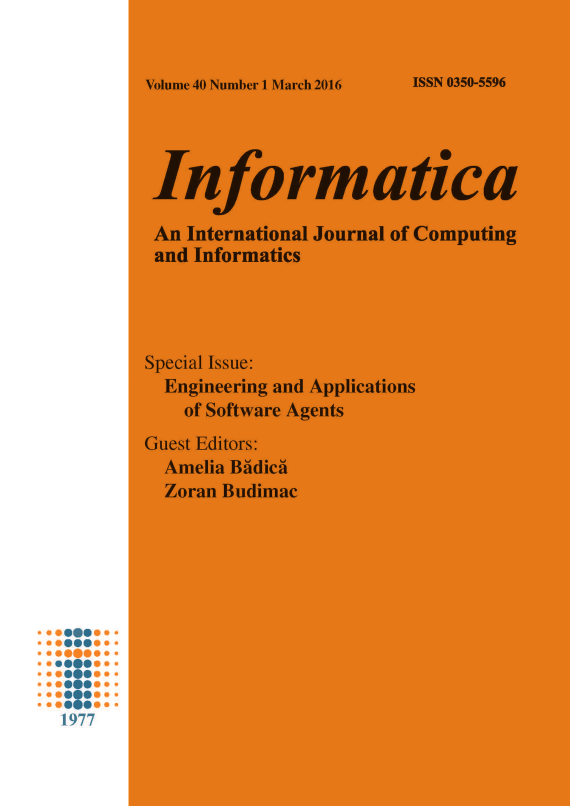Parameter tuning of PI-controller with Bat algorithm
Abstract
Correct input controller parameter settings are vital and in constant connection with output functions - e.g. robotic positioning. Optimal positioning of robotic arm auto-matically provides a high level of safety and functionality. The rst prevents robot from hurting any people around or even itself, while the second ensures robot advantage. In order to improve both safety and functionality, we propose two nature-inspired algorithms for parameter tuning of PI-controller and test them on the laboratory robotic manipulator. However the manipulator is not designed to perform a real robotic work, it offers a detailed approach of positioning control. Our goal is to access the positioning control unit and combinatorially set the input controller parameters with the help of two implemented algorithms. This principle is called automatic parameter tuning, which rstly tests the corresponding setting, then evaluates it and nally tries to improve former result with new one.
References
T. Back. Evolutionary algorithms in theory and practice: evolution strategies, evolutionary programming, genetic algorithms. Oxford university press, 1996. [2] C. Darwin. R.(1859): On the origin of species by means of natural selection. Murray. London, 1871.
R. C. Eberhart and J. Kennedy. A new optimizer using particle swarm theory. In Proceedings of the sixth international symposium on micro machine and human science, volume 1, pages 39{43. New York, NY, 1995.
W. R. Evans. Control system synthesis by root locus method. American Institute of Electrical Engineers, Transactions of the, 69(1):66{69, 1950.
I. Fister, S. Fong, J. Brest, and I. Fister. A novel hybrid self-adaptive bat algorithm. The Scientific World Journal, 2014, 2014.
I. Fister, S. Fong, J. Brest, and I. Fister. Towards the self-adaptation in the bat algorithm. In Proceedings of the 13th IASTED international conference on artificial intelligence and applications, 2014.
I. Fister, D. Strnad, X.-S. Yang, and I. Fister Jr. Adaptation and hybridization in nature-inspired algorithms. In Adaptation and Hybridization in Computational Intelligence, pages 3{50. Springer, 2015.
I. Fister Jr, D. Fister, and I. Fister. Differential evolution strategies with random forest regression in the bat algorithm. In Proceedings of the 15th annual conference companion on Genetic and evolutionary computation, pages 1703{1706. ACM, 2013.
I. Fister Jr, D. Fister, and X.-S. Yang. A hybrid bat algorithm. Elektrotehniški vestnik, 2013. [10] A. H. Gandomi, X.-S. Yang, A. H. Alavi, and S. Talatahari. Bat algorithm for constrained optimization tasks. Neural Computing and Applications, 22(6):1239{1255, 2013.
M. R. Garey and D. S. Johnson. Computers and Intractability: A Guide to the Theory of NP-Completeness. W. H. Freeman & Co., New York, NY, USA, 1979.
D. E. Goldberg and K. Deb. A comparative analysis of selection schemes used in genetic algorithms. Foundations of genetic algorithms, 1:69{93, 1991.
D. E. Goldberg and J. H. Holland. Genetic algorithms and machine learning. Machine learning, 3(2):95{99, 1988.
D. R. Griffin. Listening in the dark: the acoustic orientation of bats and men. 1958.
A. Jagarinec. Adaptivni regulator z mehko logiko za dvoosni SCARA mehanizem. Diplomsko delo : Univerza v Mariboru, Fakulteta za elektrotehniko, računalništvo in informatiko, 2005.
L. H. Keel and S. P. Bhattacharyya. A bode plot characterization of all stabilizing controllers. Automatic Control, IEEE Transactions on, 55(11):2650{2654, 2010.
M. Kolar. Vodenje SCARA robota z mehko logiko. Diplomsko delo : Univerza v Mariboru, Fakulteta za elektrotehniko, računalništvo in informatiko, 2005.
H. Makino, N. Furuya, K. Soma, and E. Chin. Research and development of the scara robot. In Proceedings of the 4th International Conference on Production Engineering, pages 885{890, 1980.
T. Slanič. Genetski regulator za dvoosnega SCARA robota. Diplomsko delo : Univerza v Mariboru, Fakulteta za elektrotehniko, računalništvo in informatiko, 2006.
A. M. Turing. Intelligent machinery, a heretical theory. The Turing Test: Verbal Behavior as the Hallmark of Intelligence, page 105, 1948.
J. Cas. Izdelava zveznega nevronskega sliding-mode regulatorja za teleoperiranje SCARA robota. Diplomsko delo : Univerza v Mariboru, Fakulteta za elektrotehniko, računalništvo in informatiko, 2006.
M. Čurkovič. Vgrajeni sistemi DSP/FPGA v sistemih vodenja. Magistrsko delo Univerza v Mariboru, Fakulteta za elektrotehniko, računalništvo in informatiko, 2010. [23] X.-S. Yang. A new metaheuristic batinspired algorithm. In Nature inspired cooperative strategies for optimization (NICSO 2010), pages 65{74. Springer, 2010.
X.-S. Yang. Bat algorithm for multiobjective optimisation. International Journal of Bio-Inspired Computation, 3(5):267{ 274, 2011.
Downloads
Published
Issue
Section
License
I assign to Informatica, An International Journal of Computing and Informatics ("Journal") the copyright in the manuscript identified above and any additional material (figures, tables, illustrations, software or other information intended for publication) submitted as part of or as a supplement to the manuscript ("Paper") in all forms and media throughout the world, in all languages, for the full term of copyright, effective when and if the article is accepted for publication. This transfer includes the right to reproduce and/or to distribute the Paper to other journals or digital libraries in electronic and online forms and systems.
I understand that I retain the rights to use the pre-prints, off-prints, accepted manuscript and published journal Paper for personal use, scholarly purposes and internal institutional use.
In certain cases, I can ask for retaining the publishing rights of the Paper. The Journal can permit or deny the request for publishing rights, to which I fully agree.
I declare that the submitted Paper is original, has been written by the stated authors and has not been published elsewhere nor is currently being considered for publication by any other journal and will not be submitted for such review while under review by this Journal. The Paper contains no material that violates proprietary rights of any other person or entity. I have obtained written permission from copyright owners for any excerpts from copyrighted works that are included and have credited the sources in my article. I have informed the co-author(s) of the terms of this publishing agreement.
Copyright © Slovenian Society Informatika








